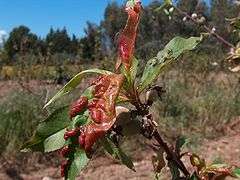Taphrina deformans
| Taphrina deformans | |
|---|---|
 | |
| Scientific classification | |
| Kingdom: | Fungi |
| Division: | Ascomycota |
| Class: | Taphrinomycetes |
| Order: | Taphrinales |
| Family: | Taphrinaceae |
| Genus: | Taphrina |
| Species: | T. deformans |
| Binomial name | |
| Taphrina deformans (Berk.) Tul. (1866) | |
| Synonyms | |
| |
Taphrina deformans is a fungus and plant pathogen, and a causal agent[s] of peach leaf curl.[1]
Life cycle
Taphrina deformans infects species of the genus Prunus (including P. amygdalus (almond) and P. persica (peach)).[2] It has been observed that this fungus also infects the fruits of some South American trees like Ocotea puberula, Nectandra megapotamica and other Lauraceae species. Infected leaves develop a whitish bloom as the infection progresses. This bloom consists of asci that break through the cuticle of the leaf by way of lysis.[3] One ascus contains eight ascospores that create conidia, which are ejected in early summer and moved by rain and wind. This fungus is believed to survive the winter by staying on the surface of the new host plant, such as on bark or buds.[4] In the spring, new buds are infected by the conidia as the leaves emerge from the buds. The disease does not occur every year, as it requires a minimum of 3mm of rainfall followed by at least 12 days during which the developing conidia remain damp and at temperatures below 19°C.[5][6] The fungus has higher infection rates following cooler, damper winters.[6]
Taphrina deformans hyphae growing in intercellular spaces secrete polysaccharide-degrading enzymes, such as cellulase, causing partial dissolution of the host cell wall. This process also results in changes in the plasma membrane.[3] T. deformans also produces the auxin indole-3-acetic acid from L-tryptophan via indole-3-pyruvic acid and indole-3-acetaldehyde. This process is thought to be responsible for the hyperplastic effect of the infection.[7]
References
- ↑ Peach leaf curl, Taphrina deformans at West Virginia University
- ↑ Mix AJ. (1956). “Notes on Some Species of Taphrina”. Transactions of the Kansas Academy of Science 59 (4): 465-482
- 1 2 Bassi M, Conti GG, & Barbieri N. (1984). “Cell wall degradation by Taphrina deformans in host leaf cells.” Mycopathologia 88 (2-3) 115–125
- ↑ Gray, William D.. The Relation of Fungi to Human Affairs. New York: Henry Holt and Company, Inc., 1959. Print.
- ↑ Rossi V, Bolognesi M, Languasco L, & Giosuè S. (2006). “Influence of Environmental Conditions on Infection of Peach Shoots by Taphrina deformans” Ecology and Epidemiology 96 (2) 155-163
- 1 2 Smith, S.E. What is Peach Leaf Curl? 2009. WiseGEEK. 14 Apr 2009 <http://www.wisegeek.com/what-is-peach-leaf-curl.htm>
- ↑ Yamada Y, Tsukamoto H, Shiraishi T, Nomura T, & Oku H. (1990). “Detection of Indoleacetic Acid Biosynthesis in Some Species of Taphrina Causing Hyperplastic Diseases in Plants” Annals of the Phytopathological Society of Japan. 56 532–540
External links
- Taphrina deformans in Index Fungorum
- Taphrina deformans at Fungal Databases
| Wikimedia Commons has media related to Taphrina deformans. |